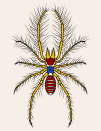|
|
|
|
|
THE SHIP an early symbol of the church
Bearings of ships are often met with in Heraldry. They symbolize some notable expedition by sea, by which the first bearer had become famous.
The single-mast Galley and the Lymphad or Lymphiad seem to be the most prevalent.
There are also full sailing ships, pirate ships, Viking ships and much more. If a ship is borne without a mast it is said to denote tragedy at sea.
The ship was also an early symbol of the church as a place where the voyagers of faith could gather and sail over the rough areas of life to the good destination God had for them.
Other cultures believed the ship was like a planet or star revolving around its centre, it is the earth and the image of life. Man is navigating the ship as a symbol of life, determining both its centre and its course. |
----------------------------- THE TOUCAN Sacred to the Incas and revered by the Maya
This beautiful and colorful rainforest bird has been associated with evil spirits, and said to be the incarnation of a demon; the father of a new child must not eat Toucan flesh as it might bewitch the new-born child and cause it to fade away…so the myth goes.
The Spanish weren't too sure what to think of the bird, but they did give it its name.
Sacred to the Incas and revered by the Maya, the Toucan was a mystic symbol and a tribal totem; the medicine men considered it an incarnation to fly to the spirit world. |
TORN
An ancient name for a spinning wheel. It is said the spinning wheel was probably invented in India, though its origins are obscure. It reached Europe via the Middle East in the European Middle Ages.
The Saxon, or Saxony wheel, introduced in Europe at the beginning of the 16th century, incorporated a bobbin on which the yarn was wound continuously; the distaff on which the raw fibre was held became a stationary vertical rod, and the wheel was actuated by a foot treadle, thus freeing both of the operator's hands. Another of the many weavers symbols often found in heraldry.
Other than being an emblem representative of the trade, the spinning wheel has no heraldic symbolism that the author could find.
THE TOWER A castle tower. The emblem of grandeur and society.
|
|
|
|
|
 |
THE SPIDER symbolizes tenacity of purpose To Ancient Egyptians and Greeks, the Spider was symbolic of the fates that constantly wove at the web of each person's destiny. To the Christian, the Spider's web was representative of human frailty and the temporary nature of earthly existence and riches. In Greek mythology Arachne, challenged Athene, Zeus' daughter, to a weaving contest, and hanged herself when the goddess destroyed her web. Athene then changed her into a Spider, condemned for eternity to hang at the end of her thread. In heraldry the spider symbolizes tenacity of purpose, heedfulness, and cunning. |
|
|
|
The World's Leader in Heraldry Art |
|
|
|
|
|
|
Copyright 2001-2020 - Armorial Gold Heraldry Services - Site Design & Graphics by Armorial Gold Heraldry Services. All Heraldry Art, Heraldry Clipart, Gods and Goddesses Clipart, Saints Collection, Italian Coats of Arms, Birds of Prey Clipart. Heraldic Alphabets, Spanish Coats of Arms, and all other heraldic, coats of arms, or companion images contained in this site including downloads are copyright of Armorial Gold Heraldry Services. The Heraldry Clipart is hand drawn by Armorial Gold Heraldry. Heraldic art samples are provided as a courtesy to potential buyers and the heraldry samples remain the property of Armorial Gold Heraldry Services. Reproduction in any form other than in the manner stipulated in the Armorial Gold Heraldry Services license agreement or FAQ section is strictly prohibited. All heraldic and companion images purchased through this site are governed by a license agreement executed between the buyer and Armorial Gold Heraldry Services |